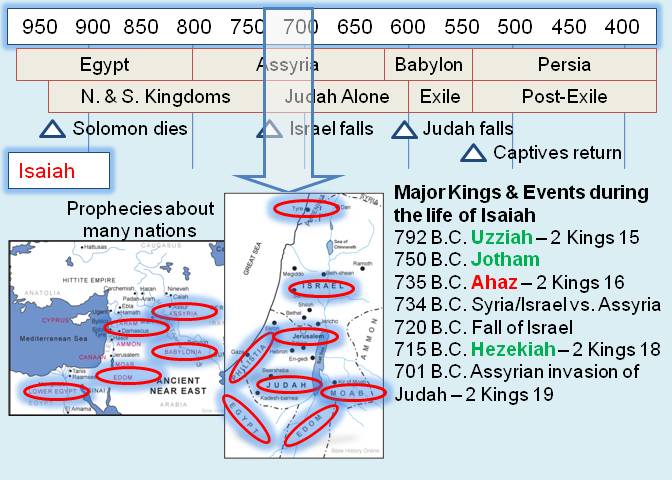A Survey of the Prophets - Isaiah
|
Historical Background of the Book. See the historical background of the book of Hosea.
The Author and the Audience. Isaiah, whose name means "The Lord saves", was the son of Amoz and prophesied between 740 and 690 B.C. He witnessed the prophesied destruction of Israel by the Assyrians and experienced the threats of Assyria against Judah. His primary audience were the kingdoms of Israel and Judah. Like Israel, Judah was guilty of numerous sins, including social injustice, exploitation of the poor, and seeking strength from political alliance with Egypt against the Assyrians instead of trusting in the Lord. Isaiah also delivered warnings and prophecies to a large number of surroundings nations. Many of these would be like Israel and Judah be threatened or conquered by the expanding Assyria empire as well as the Babylonian empire that would be following it in about 100 years. |
Outline/Major Themes. The book of Isaiah consists of four main sections:
- Ch. 1-31 Judgments against the nations: primarily Israel & Judah (Ch. 1-12, 28-31), but also Babylon, Assyria, Philistia, Moab, Damascus, Egypt, Arabia, Tyre, the whole earth, and Israel
- Ch. 32-35 Joy for the righteous
- Ch. 36-39 Historical background (around 701 B.C. with the Assyrian invasion by Sennacherib of Judah, the reign of King Hezekiah, and the prediction of Babylonian captivity about 100 years in the future
- Ch. 40-66 Future events: including the reign of Cyrus about 160 years in the future, the Suffering Servant, and the coming Messiah.
- God is aware of different nations and peoples
- "The Day of the Lord" in judgment
- Jesus, the Suffering Servant and Savior (Ch. 53; Matt. 1:18-25; Acts 8:32-35; Heb. 9:28; 1 Pet. 2:22-25)

